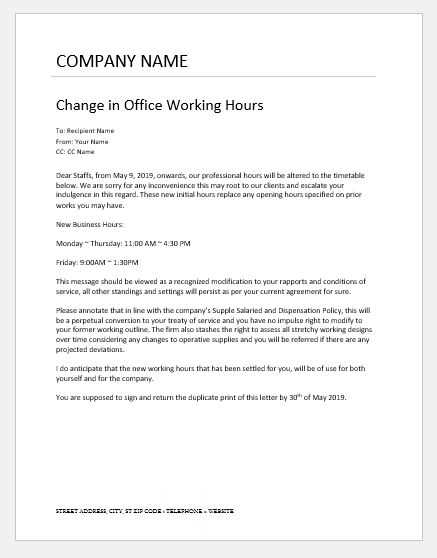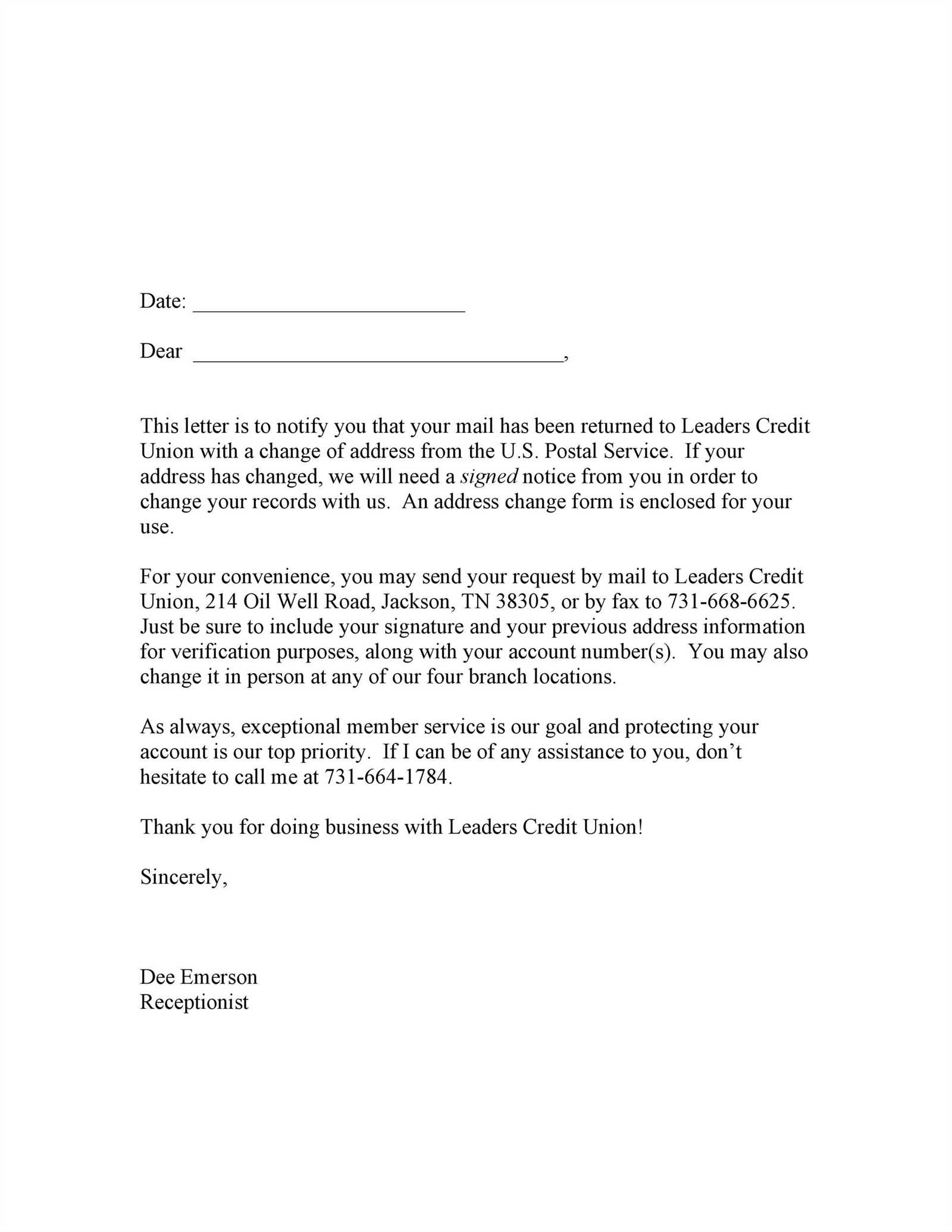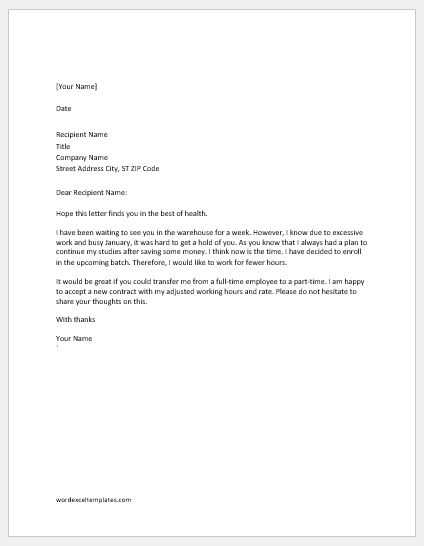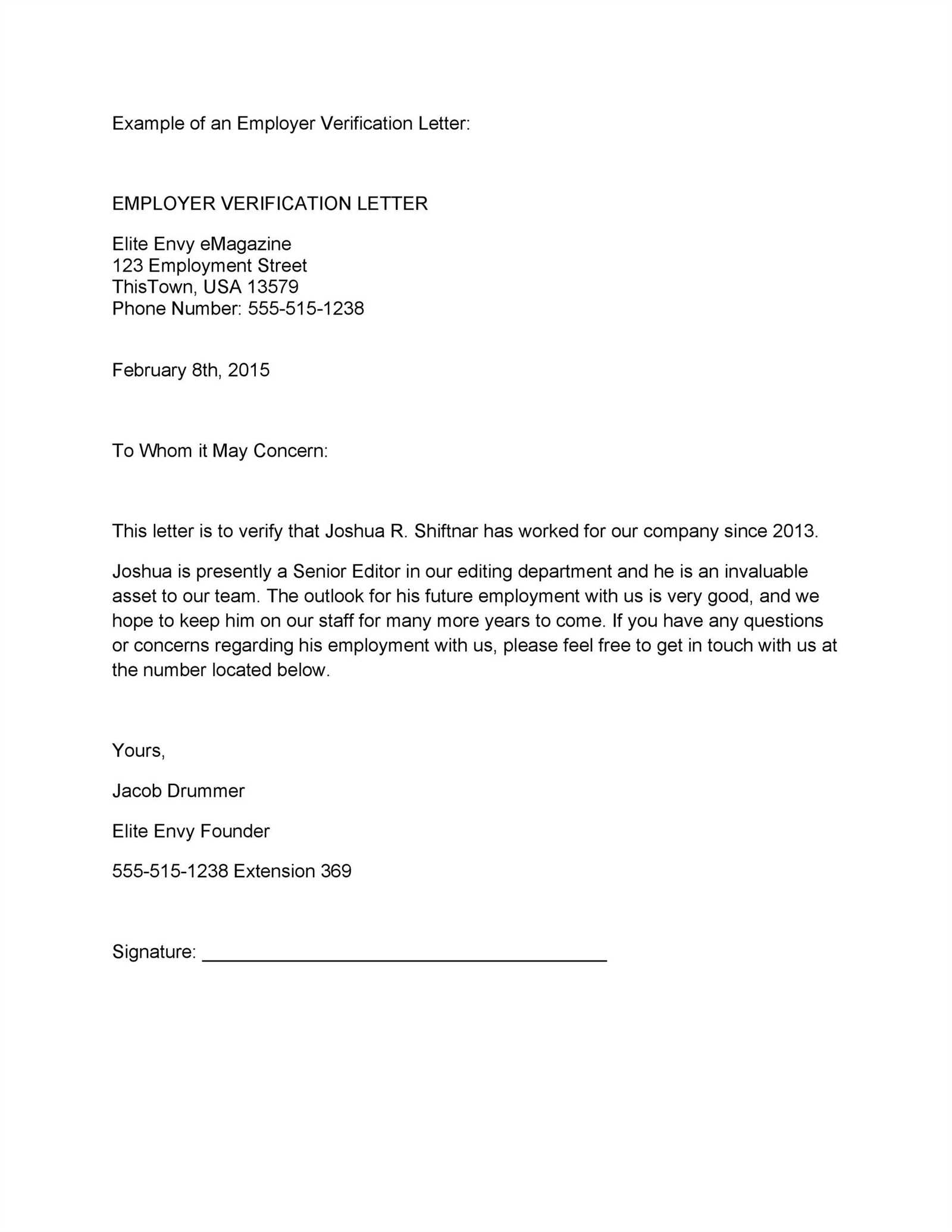Change of hours letter to employee template

Notify your employees about a change in work hours clearly and respectfully with a simple and direct letter. Begin by acknowledging the shift in schedule and providing necessary details about the change. This helps maintain transparency and ensures that all employees are on the same page regarding their new work hours.
Start by stating the specific dates or times the change will occur. Mention how this change may affect their daily routine or work assignments. Be sure to communicate the reason behind the change, if applicable, and how it will benefit both the company and the employees.
Next, include any necessary instructions or expectations that come with the new schedule. Highlight any new procedures, contact points, or requirements employees need to be aware of moving forward. Keeping the tone positive and clear helps to reduce any potential confusion or frustration.
Conclude with an offer for employees to reach out if they have questions or need further clarification. Ensure they feel supported and that you are available to help them adjust to the new work hours smoothly.
Here’s the revised version:
When notifying an employee about a change in their work hours, it is important to keep the tone clear and direct. A well-structured letter helps avoid misunderstandings and ensures the message is received without confusion.
Steps for writing the letter:
- Start with the subject line: Make sure the subject clearly states the purpose, like “Notification of Change in Work Hours”.
- Greet the employee: A simple greeting like “Dear [Employee’s Name]” sets a professional tone.
- State the reason for the change: Be concise. Mention any shifts in scheduling or business needs that are driving the adjustment.
- Provide specific details: Clearly outline the new work hours, including the days and times, so there is no room for ambiguity.
- Offer support: If applicable, let the employee know how they can reach out for clarification or if they need assistance with the change.
- Close professionally: End the letter with a polite closing such as “Sincerely” or “Best regards”.
By keeping the letter focused and clear, you ensure the employee understands the change and feels supported in adapting to the new schedule.
- Change of Hours Letter to Employee Template
Use this letter template to notify your employee about a change in their working hours. Make sure to include key details such as the new schedule, the date it will take effect, and any relevant expectations moving forward.
Template Example

Dear [Employee’s Name],
We are writing to inform you about a change in your working hours. Starting from [Effective Date], your new working hours will be [New Hours], which will replace your current schedule of [Old Hours].
Please ensure that you adjust your personal and professional commitments accordingly. If you have any questions or concerns regarding this change, do not hesitate to reach out to [Supervisor’s Name] or [HR Department Contact].
We appreciate your understanding and flexibility in accommodating this adjustment. We look forward to your continued dedication and contribution to the team.
Sincerely,
[Your Name]
[Your Position]
Additional Notes

Be clear and concise when explaining the change to avoid confusion. You can also include any additional steps the employee may need to take, such as adjusting their timesheets or meeting with their manager. This helps ensure a smooth transition for both the employee and the company.
Adjusting work hours can directly improve operational efficiency and employee satisfaction. Companies face varying demands, often requiring flexibility in work schedules. By modifying hours, businesses can meet peak periods, balance workloads, and address shifts in customer needs. This flexibility helps organizations adapt without overburdening employees.
Aligning with Business Objectives
When business objectives shift, work hours should align with these changes. Whether expanding operations or adjusting to market trends, modifying work hours ensures that staff is available during the most critical times. This also minimizes the impact of overstaffing or understaffing, optimizing resources.
Enhancing Employee Well-being
Adjusting hours gives employees better control over their work-life balance. Flexible hours help staff manage personal obligations, reduce stress, and increase job satisfaction. A well-rested workforce is often more productive and engaged, which benefits both the employee and the organization.
Clarify the reason for the change right at the beginning. Explain why the working hours are being adjusted, whether it’s due to business needs, seasonality, or company policy changes. This sets the context for the reader.
State the new hours clearly. Specify the exact start and end times of the new shift, as well as the days that will be affected. This removes any ambiguity and provides a clear understanding of the changes.
Outline the effective date. Indicate when the new hours will begin, giving employees enough time to adjust their schedules. If there is a transition period, mention it as well.
Highlight any impact on compensation or benefits. If the change in hours affects pay, overtime, or other work-related benefits, explain how these will be addressed to avoid confusion.
Provide contact information for questions. Let employees know who they can reach out to for clarification or concerns regarding the change. This helps address any immediate queries and prevents miscommunication.
End on a positive note. Encourage employees to adjust to the new schedule and thank them for their understanding. This helps maintain morale and assures them that the change is in the best interest of the company.
Begin by providing clear, specific details about the adjustment, such as the new hours, the reason for the change, and how it may affect the employee’s schedule. Avoid any ambiguity to ensure the employee can easily understand the update.
Use Direct and Positive Language
Communicate the change using straightforward language that leaves no room for misinterpretation. Use a friendly yet professional tone to maintain a positive atmosphere, even if the changes may inconvenience the employee. Show appreciation for their understanding.
Offer Support and Answer Questions
Anticipate potential questions or concerns from the employee. Be open to discussing the change in further detail and offer support. This ensures the employee feels heard and reassured about the adjustment.
Provide employees with sufficient time to adjust to schedule changes. A minimum of 24-48 hours notice is recommended to avoid confusion and ensure they can make necessary arrangements. Inform employees as soon as possible to help them plan for any personal or professional commitments. If changes are frequent, establish a clear procedure for notifying employees to reduce uncertainty. Consistency in communication is key to maintaining trust and minimizing disruptions. Use multiple channels, such as emails or messaging platforms, to deliver the notice and ensure employees receive it promptly.
When adjusting work hours, employees may have several concerns. Addressing them directly in your communication will help maintain trust and ensure smooth transitions. Start by acknowledging their possible worries, such as schedule changes affecting personal time, workload distribution, or potential conflicts with other responsibilities.
Clarify the Reasons Behind the Change
Clearly explain why the change is happening. Whether it’s due to company needs, external factors, or operational efficiency, transparency helps employees understand the bigger picture. This reduces uncertainty and reassures them that decisions are made thoughtfully, not arbitrarily.
Provide Solutions or Alternatives

Offer practical solutions for employees who may face challenges with the new schedule. For example, if certain employees need a specific time slot, allow room for flexibility or discuss potential adjustments on a case-by-case basis. Offering options makes employees feel their needs are considered and valued.
- Provide contact information for further questions.
- Set up a feedback process to gather input and address concerns promptly.
Ensure your tone is empathetic, showing that you care about their well-being while balancing company needs. This approach helps foster collaboration and minimizes disruption during the transition.
Before adjusting an employee’s working hours, employers must ensure they comply with labor laws and contractual obligations. Any changes must be legally sound to avoid disputes and potential claims. Familiarize yourself with local labor regulations and the terms outlined in the employment contract. Below are key points to consider:
| Aspect | Recommendation |
|---|---|
| Employment Contracts | Review the contract to check if work hours are explicitly stated. Modifications without employee consent could breach the contract. |
| Overtime Regulations | Understand the overtime laws in your jurisdiction. Any change in hours that leads to overtime could require additional pay or benefits. |
| Minimum Wage Laws | Ensure that the adjusted hours comply with local minimum wage laws. Any reduction in hours should not lower the total earnings below the legal threshold. |
| Employee Consent | Obtain explicit consent from employees for any modifications to their working hours. A written agreement can help prevent misunderstandings. |
| Collective Bargaining Agreements | Check if a union agreement governs work hours. Modifying hours without consulting the union may violate the agreement and lead to legal challenges. |
Employers should also document all changes made to work hours and maintain open communication with employees to address any concerns. Regular consultations help ensure both parties remain in agreement and compliant with the law.
Change of Hours Letter to Employee Template
When informing an employee about a change in their working hours, the message must be clear and direct. Be specific about the new hours and include any relevant details, such as the reason for the change, to avoid confusion. Mention the effective date and ensure the employee understands the expectations going forward. Keep the tone respectful and professional to maintain a positive relationship.
Example of a change of hours letter:
Dear [Employee Name],
We would like to inform you of a change in your working hours, effective from [Date]. Your new schedule will be as follows:
• [New hours or shifts]
If you have any questions or concerns regarding this change, please do not hesitate to reach out. We appreciate your flexibility and understanding.
Best regards,
[Your Name]
[Your Position]
[Company Name]